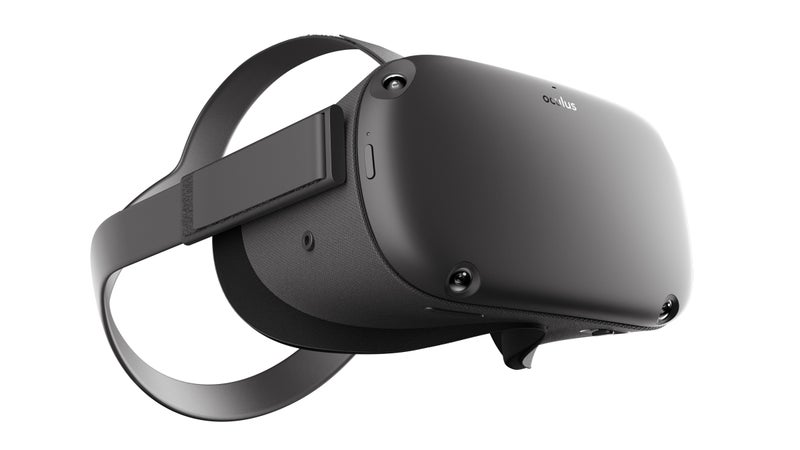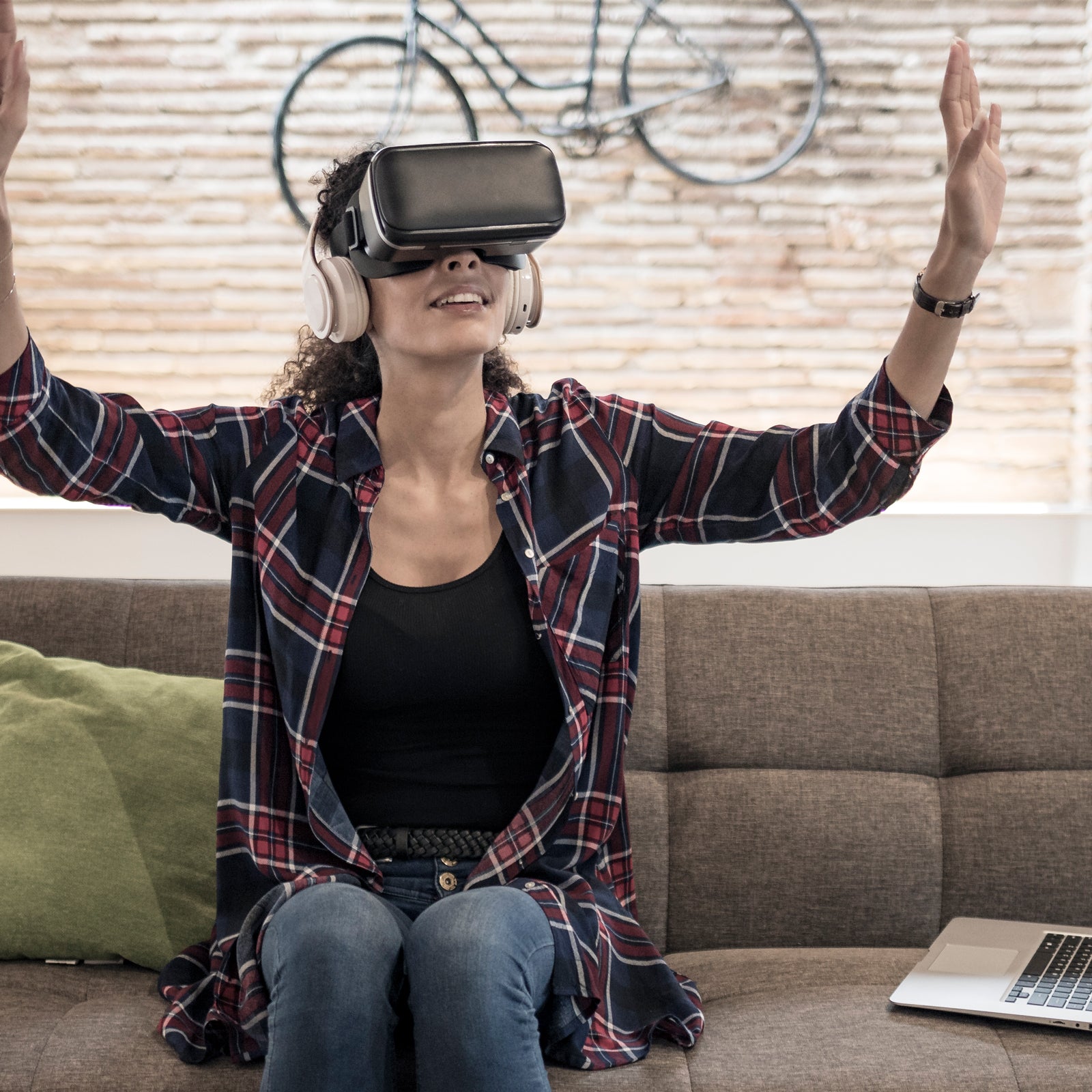Like millions of others, I have spent much of the past four╠řmonths cooped up inside. And like so many people who rely on playing outside for sanity and fitness, IÔÇÖve experienced plenty of highs and lows. But as much as I cherish time spent in nature, IÔÇÖm also a tech geek. Naturally, this got me thinking: Has virtual reality gotten good enough to help me scratch my adventure itch while on lockdown? The last time I tried VR, several years ago, I was underwhelmed. But IÔÇÖd╠řheard that the technology had come a long way since.
To be clear, IÔÇÖm not positing that VR could replace the actual outdoors, just as a hang board canÔÇÖt replace a granite wall╠řand a Zoom call canÔÇÖt replace hugging a loved one. I just wanted to know if VR could help tide me over, like a fancier version of watching ski movies to stay stoked through summer. So I got testing.
The Current State of Virtual Reality
If your last experience with virtual reality was,╠řlike mine,╠řyour smartphone placed inside a disposable cardboard viewfinder, then thereÔÇÖs good news: itÔÇÖs gotten a lot better. Specifically,╠řthe graphics and applications have improved by leaps and bounds, thanks to purpose-built goggle headsets.
Early VR setups╠řlet you look around in a 360-degree sphere, but if you moved forward or backwards, side to side, or up and down, your perspective wouldnÔÇÖt change. But head- and hand-tracking technology has resolved that. Head tracking maps your position in the virtual environment based on your position in a physical room, so you can move around freely. Hand tracking uses two controllers to allow you to╠řinteract with objects in the virtual world. That all makes for an extremely immersive and convincing experience.╠řAt first╠řthis tech required an╠řelaborate array of cameras and sensors around the room╠řand needed to be connected╠řto a separate beefy gaming computer with a high-end╠řgraphics card.

That changed in 2019, with the launch of a new headset called the ($529). Before you balk at the price, keep in mind that itÔÇÖs the first and only stand-alone rigÔÇöjust a battery-powered headset and two controllersÔÇöthat does not need to be hooked up to a high-end computer in order to deliver top-notch peformance. You download whatever apps or games you╠řwant over Wi-Fi╠řright from within the headset. Many of the running watches and GoPros ║┌┴¤│ď╣¤═° has reviewed over the years cost more and do less.
Quest units have been , especially with so many people╠řisolated in their homes. I managed to get my hands on one, though, and spent some time with it╠řto see if itÔÇÖs╠řall it is╠řcracked up to be.
Tested: Virtual-Reality ║┌┴¤│ď╣¤═°
The program that made me want to try virtual reality again was a three-part documentary called .╠řThe movie, by filmmaker and alpinist Jonathan Griffith,╠řfollows Tenji Sherpa on his quest to link the summits of Mount Everest and Lhotse without oxygen. (The project was an ode to Ueli Steck, who died before he could complete the route.) Griffith brought a 360-degree VR rigÔÇöa large array of 17 camerasÔÇöup to the top of Everest╠řand stitched the footage together later. The result╠řis seamless and immersive, with 360-degree visuals. Though you access the documentary through╠řQuest, itÔÇÖs not compatible with head tracking. This means you canÔÇÖt move forward, backwards, up, or down, but╠řyou can spin around to look in all directions during every shot.
Climbing Everest has never been on my bucket list, but have I wondered what it would be like to stand on the summit? You better believe it. At several points during the documentary I realized I was standing with my mouth hanging open in amazement. IÔÇÖve read books on this peak╠řand watched plenty of documentaries, but this marked the first time I was╠řable to see what those climbers see, as if I were there. It was╠řa magical experience.
There are a ton of other outdoor-focused experiences, too. ╠řis essentially Google Street View for beautiful places like the Great Pyramids of Egypt. ThereÔÇÖs , which casts you as a photographer on assignment in an animated but breathtaking version of the Antarctic or Machu Picchu. brings you to a make-believe underwater safari park, where you can faux-scuba-dive and interact with animated whales, manatees, and other sea creatures. (As a freediver whoÔÇÖs been missing the deep ocean, I really enjoyed this one.)
Generally, the animated experiences I just mentioned arenÔÇÖt totally realistic looking, but they offer full head╠řand hand tracking, so you can explore the worlds as if you were there. Nature experiences that use real-life photo╠řand video footage, such as the Everest documentary, are less interactive (without the head╠řand hand tracking, youÔÇÖre mostly just looking around from a fixed point in space).╠řBut being able to visit gorgeous╠řplaces while trapped inside was still extremely refreshing.
Tested: Virtual-Reality Fitness
At points during the past four months of lockdown, I have struggled with my motivation to work out. Games, however, are an easy distraction. Most of the ones you play on the Quest are best enjoyed on your feet. ThatÔÇÖs already better╠řthan sitting around and watching TV.
On the low-key end of the spectrum, I discovered rhythm-based games that are set to music, like a full-body version of Guitar Hero. One example: has you leaning and ducking to avoid obstacles╠řand hitting targets with your hands as they fly at you to╠řthe beat of a song. It truly╠řdoes feel like dancing. I clocked my heart rate at 154 beats per minute playing something that isnÔÇÖt even marketed as an exercise app.
There are also some no-joke workouts. Leading the charge is a new Quest-exclusive app called . ItÔÇÖs a rhythm-based program that involves using virtual bats to smash targets coming at you to╠řthe beat. While you do that, you also have to get under, around, or through various obstacles, which translates to doing fast squats and lunges, all set to a soundtrack that ranges from Lizzo and Kendrick Lamar to Fleetwood Mac and Chaka Khan. The backdrops are stunning, photo-realistic, 360-degree panoramas of real places like Glenn Coe, Scotland, and IcelandÔÇÖs Blue Lagoon. At one point, my heart rate was up to 179 beats per minute, which is more than I get with most workouts.
Other notable exercise apps include boxing games , , and . Thrill of the Fight in particular truly╠řfeels like sparring (minus getting punched in the head). After three three-minute rounds, I was gasping for air and my shoulders were burning.
One day in particular,╠řI just didnÔÇÖt feel like doing anything. But I managed to get myself to play one game on the Quest. Before I knew it, I was dancing in a virtual club (in a game called Dance Central)╠řand then doing a full, challenging workout and having a really good time. An hour flew by, and I burned almost 700 calories. Fun is a powerful motivator.
Tested: Virtual-Reality Games
It shouldnÔÇÖt be a surprise that a system built primarily for gaming would excel at it. There are stunning adventure apps like , where you control a tiny hero mouse on a quest to defeat magical villains, and , a╠řbow-and-arrow shooter game set╠řin a postapocalyptic alternate dimension. Climbers will appreciate a game called , which features routes of varying difficulties in made-up areas that conjure an island in Thailand, the red rocks of the American Southwest, and the French Alps.
One of my best friends, an ER doctor in Los Angeles, has been using his Quest to de-stress in between shifts. WeÔÇÖve been able to compete in futuristic racketball, as zombie shooters, and in a sort of zero-gravity, full-contact ultimate Frisbee called . ItÔÇÖs a lot more fun than Zoom.
Takeaways
Going into testing, I had no expectations that virtual reality could replace true outdoor experiences. I felt the same way coming out of it. There is no substitute for the feeling of water on your skin, dirt under your shoes, or fresh air in your lungs. But it did make me feel like I was going places and having adventures at a time when I couldnÔÇÖt. It even afforded me experiences I will almost certainly never have in real life.
As for the Oculus Quest itself, IÔÇÖve been extremely impressed so far. It was easier to set up than most fitness watches I test. The graphics, performance, and responsiveness are all more than enough for my needs. Negatives? Because the weight is all up front, I do feel some strain in the back of my neck after long sessions, and the battery lasts only two to two and a half hours. It also costs $100 more than the current generation Xbox or PlayStation (plus the cost of games, which generally run between $10 and $30). In other words: itÔÇÖs far from cheap. But for an all-in-one system that has been able to transport me in ways that those others canÔÇÖt, itÔÇÖs pretty unbeatable.


